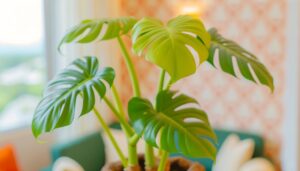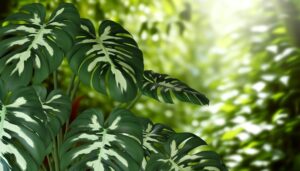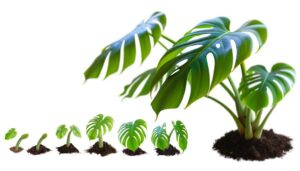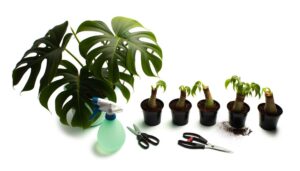Monstera Dubia Leaf Care
For Monstera Dubia leaf care, maintain bright, indirect light to prevent scorching. Keep humidity levels between 60-80%, using tools like humidifiers or pebble trays.
Water when the top inch of soil dries out, using dechlorinated, room-temperature water. Opt for a well-draining soil mix with peat moss, perlite, and orchid bark.
Feed with a balanced, water-soluble fertilizer and aim for slightly acidic to neutral pH. Watch out for overwatering, pests, and poor lighting, as these can cause issues like root rot and leggy growth.
By carefully monitoring these conditions, you'll help your Monstera thrive. Discover more essential tips next.
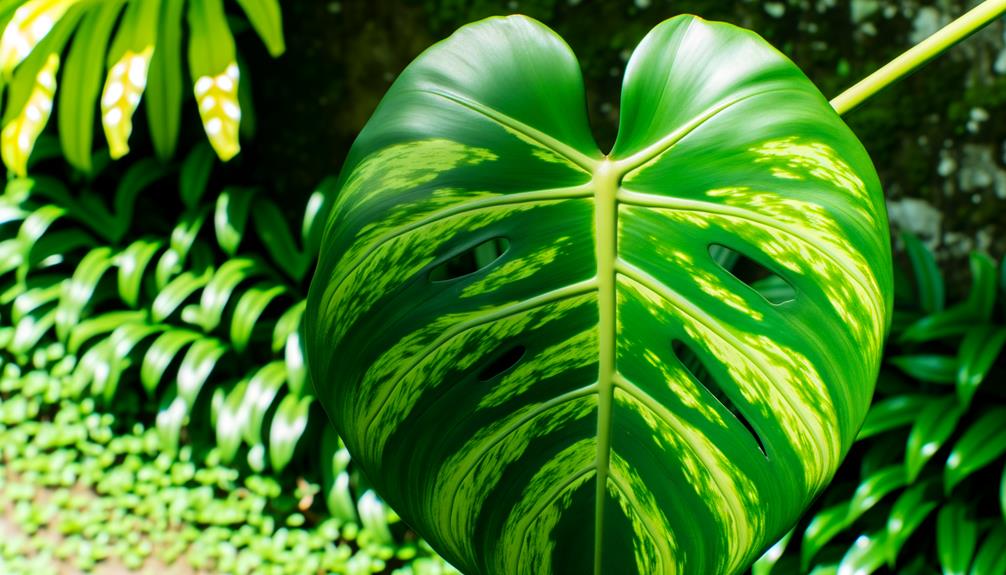
Key Takeaways
- Place Monstera Dubia in bright, indirect light to prevent leaf scorching.
- Maintain humidity levels at 60-80% to replicate rainforest conditions.
- Keep soil consistently moist, but avoid waterlogging to prevent root rot.
- Use a well-draining soil mix with peat moss, perlite, and orchid bark.
- Inspect leaves regularly for pests and treat with insecticidal soap or neem oil.
Ideal Light Conditions
To guarantee ideal growth for your Monstera Dubia, it's important to provide bright, indirect light. Direct sunlight can scorch its delicate leaves. Position your plant near a north or east-facing window where it can receive ample natural light without the risk of burning. You can also use sheer curtains to diffuse the light if your only option is a brighter window.
Avoid placing it in low light conditions, as this can slow its growth and lead to leggy stems. If natural light is insufficient, consider supplementing with fluorescent or LED grow lights, ensuring they mimic the intensity and spectrum of natural sunlight. By closely monitoring the light your Monstera Dubia receives, you'll promote healthy, vibrant foliage.
Humidity Requirements
Maintaining high humidity levels around 60-80% is essential for the Monstera Dubia to thrive and develop lush, healthy leaves. This tropical plant hails from rainforests where moisture is abundant, so replicating these conditions at home is key.
You can use a hygrometer to monitor humidity levels accurately. If your home's air is too dry, consider these methods to boost humidity:
- Humidifiers: Place a humidifier near the plant to maintain ideal moisture levels.
- Pebble Trays: Set the pot on a tray filled with water and pebbles, ensuring the pot's base isn't submerged.
- Grouping Plants: Cluster your Monstera Dubia with other plants to create a microenvironment with higher humidity.
These techniques will support the plant's natural growth patterns.
Watering Tips
When watering your Monstera Dubia, make sure the soil remains consistently moist but not waterlogged to prevent root rot. Use room-temperature, dechlorinated water to avoid shocking the roots. Water the plant thoroughly until excess water drains from the pot's bottom, ensuring even moisture distribution.
During the growing season, typically spring and summer, you'll need to water more frequently, as the plant's metabolic activities are heightened. In contrast, reduce watering in fall and winter when growth slows. Always check the top inch of soil; if it feels dry, it's time to water.
Additionally, consider using a moisture meter for precise readings. Proper watering not only supports healthy leaf development but also prevents diseases associated with improper hydration.
Soil and Fertilizer
A well-draining, aerated soil mix rich in organic matter provides the ideal environment for Monstera Dubia's roots to thrive. You'll want to create a balanced mix that retains moisture without becoming waterlogged. Peat moss, perlite, and orchid bark are excellent components.
Fertilizing your Monstera Dubia is essential for vibrant growth. Use a balanced, water-soluble fertilizer diluted to half strength every four to six weeks during the growing season.
To enhance soil and fertilizer:
- Soil Mix: Combine 50% peat moss, 25% perlite, and 25% orchid bark for best drainage and aeration.
- Fertilizer Schedule: Apply a balanced, water-soluble fertilizer every 4-6 weeks.
- Soil pH: Aim for a slightly acidic to neutral pH (5.5-7.0).
This guarantees robust, healthy growth.
Common Problems
Common issues with Monstera Dubia often arise from improper watering, pest infestations, and inadequate light. Overwatering can cause root rot, evident by yellowing leaves and a soft stem. Make sure the soil drains well and let the top inch dry before watering again.
Pests like spider mites and mealybugs are common; you can address infestations with insecticidal soap or neem oil.
Insufficient light leads to leggy growth and small leaves. Position your Monstera Dubia in bright, indirect light to encourage robust foliage. If you observe slow growth or pale leaves, consider adding a grow light.
Regularly examine your plant for these issues to sustain its vitality and vibrancy.
Conclusion
Caring for Monstera dubia can feel like balancing light and shadow. Provide bright, indirect light but avoid harsh sun.
Embrace humidity, mimicking its native tropics, while keeping soil consistently moist yet not waterlogged. Use well-draining soil enriched with balanced fertilizer for robust growth.
Be vigilant against pests and yellowing leaves. By mastering these nuances, you'll cultivate a thriving Monstera dubia, showcasing your meticulous care and nature's intricate beauty.

